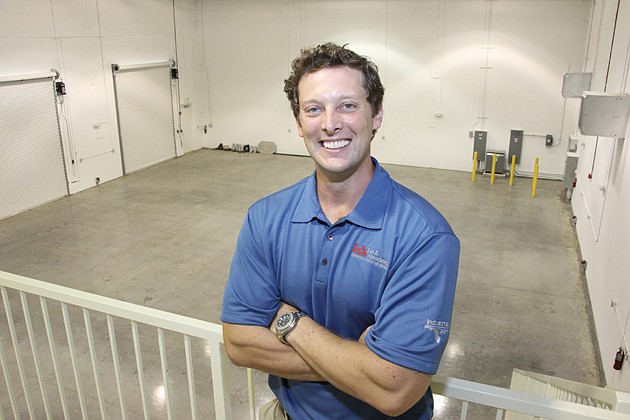- December 13, 2025
-
-
Loading

Loading

Warehouses are the vanilla flavor of the commercial real estate business, but their vacancy rate is an important gauge of the health of the regional economy.
In the first quarter of this year, tenants absorbed 900,000 square feet of warehouse space on the Gulf Coast from Tampa to Naples. That's enough to fill more than 15 football fields.
Across the region, vacancies in warehouse buildings are decreasing as tenants move in or expand, according to data from market tracker CoStar Group. The vacancy rate has been inching down to 10% in the Tampa Bay area and to 10.3% in the tri-county area of Charlotte, Collier and Lee counties. If the trend continues, vacancy rates could be headed for single digits.
There are even pockets of opportunity for potential development in some areas, such as north Pinellas County and Lakeland, brokers say.
For example, north Pinellas' warehouse vacancy rate is down to 5.6%. “North Pinellas has done very well because it's a small market and you have a lot of population,” says Bruce Vaughan, managing director of Colliers International Tampa Bay Florida's industrial services group.
Meanwhile, Lakeland has become a distribution hub for companies that want to service Orlando, Tampa and points further south. “Lakeland and Plant City are very tight,” says Bruce Erhardt, executive director with Cushman & Wakefield in Tampa. “We're going to see something happen.”
Because there hasn't been any meaningful new construction since the economic downturn began, there isn't much newer top-quality warehouse space available for lease. For example, if you're looking for a new 60,000-square-foot building in the Fort Myers (the size of a football field), you won't find it, says Bob Johnston, a principal and senior vice president with Lee & Associates in Fort Myers.
But despite better news on vacancies, they're still not low enough to push rents up. Rents need to rise 20% to 30% from currently depressed levels to make sense financially, brokers say. “We're in the price-to-suit market right now,” chuckles Todd Holman, a broker with Woodyard & Associates in Fort Myers.
And there's some concern that the vacancy rate may be higher than is reported. “There's a lot of shadow space and a lot of leases that have defaulted, but some landlords are not claiming them,” says Vaughan.
Tenant activity increases
Leases that were signed during the boom times are starting to expire, and that is generating more activity than normal. “The activity we're seeing is lateral moves to cheaper space,” says Jan Boltres, managing director with Colliers International Tampa Bay.
However, Boltres says he's seen a few construction-related firms in the market looking to expand. “The building-products guys got killed in the downturn, so to see those types of businesses back in the market is positive,” he says.
In Pinellas, Vaughan says larger users in the 50,000- to 150,000-square-foot range have been looking at leasing space. “We are seeing some of the medical, pharmaceutical and defense contractors probing and looking at certain buildings,” he says. “The good news is that behind that is the smaller groups that feed them.”
Further south in the Fort Myers area, leasing and purchasing inquiries are up. “I'm getting a lot of calls from mid-sized distributors,” says Holman. “I'm not seeing them leaving town anymore.”
Holman says despite the increase in residential-construction activity, he hasn't yet seen demand from building-products companies. Instead, they're a wide variety of users, mostly distributors looking for smaller space of 5,000 square feet or so. For example, Holman recently leased space for a distributor of Middle Eastern holiday decorations. “Most of the calls for larger space is for people looking to downsize,” Holman says.
Build to suit
For developers, rents need to rise to at least $5 to $6 a square foot, net of expenses, to make a warehouse building profitable. Because most rents are now less than $5, developers won't build speculatively.
In places such as Lakeland, which has vacancy rates in the mid-single digits, brokers say there's plenty of land for development and that makes developers cautious. “There's no barrier to entry,” says Erhardt, who says nine of 13 warehouse sites on the Interstate 4 corridor from Tampa to Lakeland are permitted and ready to be developed.
Still, Erhardt says speculative development of warehouse space is occurring in Orlando, and it's just a matter of time before it spreads west to Tampa.
For now, tenants that can't find newer, large blocks to top-quality space will build their own warehouses. With land and construction prices down, some companies are choosing the “build-to-suit” way.
For example, O'Reilly Automotive plans to build its own distribution facility near Lakeland, says Erhardt. The first phase will measure 300,000 square feet and the second phase will add another 200,000 square feet. “They have a site under contract,” says Erhardt.
In March, Great Bay Distributors acquired a 96-acre tract in north St. Petersburg, where it plans to build a warehouse-distribution center in the future. Great Bay is one of Florida's largest Anheuser-Busch distributors and the site was once considered as a possible location for the Tampa Bay Rays baseball stadium.
In Fort Myers, Johnston and partner Derek Bornhorst, senior vice president at Lee & Associates, are helping two distributors negotiate build-to-suit space, one for 60,000 square feet and another for 20,000 square feet. “There's no contiguous 60,000 square feet in our market,” says Johnston. “The 20,000 square feet needs a couple acres of outside storage.”